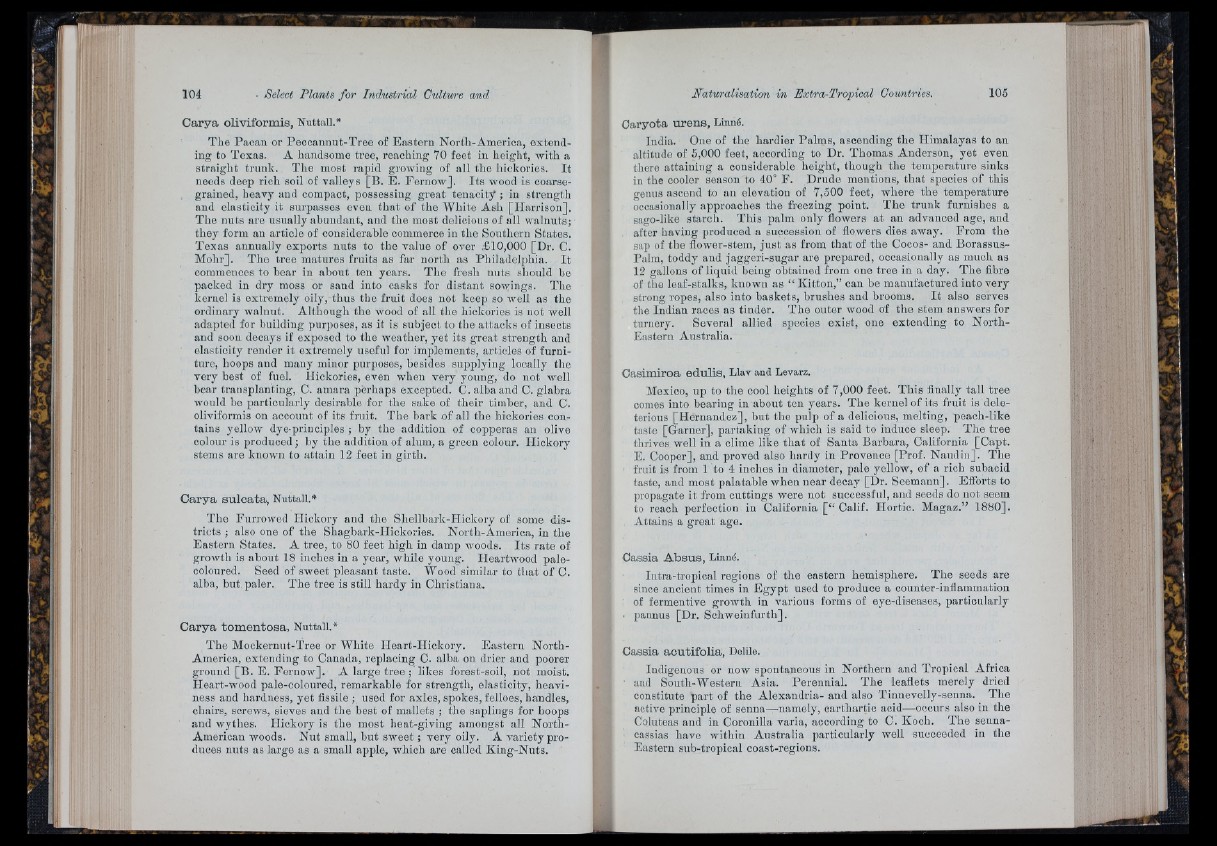
Select Plants fo r Industrial Culture and
i !
•'f !'
C a r y a o liv ifo rm is , Nuttall.*
The Paean or Peccanmit-Tree of Eastern North-America, extending
to Texas. A liandsome tree, reaching 70 feet in height, with a
straight trunk. Tlie most rapid growing of all the hickories. I t
needs deep rich soil of valleys [B. E. EeriiowJ. Its wood is coarsegrained,
lioavy aud compact, possessing groat tenacity ; in strength
and elasticity it surpasses even th a t of the White Ash [Harrison].
Tlie lints are usually abundant, and tlie most delicious of all walnuts;
tliey form an article of considerable commerce in tlie Sonthern States.
Texas annually exports nuts to tlio value of over £10,000 [Dr. C.
Molir]. The tree matures fruits as far nortli as Philadelphia. I t
commences to bear in about ten years. Tlio fresli nuts sliould be
lacked in dry moss or sand into casks for distant sowings. The
cornel is extremely oily, thus the fruit does not keep so well as the
ordinary walnut. Altliougii tlio wood of all tlie hickories is not well
adapted for building purjioses, as it is subject to the attacks of insects
and soon decays if exposed to the weather, yet its gTcat strength and
elasticity render it extremely useful for implomeiits, articles of furniture,
hoops and many minor purposes, besides supplying locally the
very best of fuel. Hickories, even when very young, do not well
bear transplanting, C. amara perliaps excepted. C. alba and C. glabra
would bo particularly desirable for the sake of their timber, and C.
oliviformis on account of its fruit. Tlie bark of all the hickories contains
yellow dye-priuciples ; by the addition of copperas an olive
colour is produced; by tlie addition of alum, a grcon colour. Hickory
stems are known to attain 12 feet in girtli.
C a r y a s u l c a t a , Nuttall.*
The Furrowed Hickory and the Sliellbark-IIickory of some districts
; also one of the Sliagbark-IIickories. North-America, in the
Eastern States. A tree, to 80 feet high in damp woods. Its rate of
growth is about 18 inches in a year, while young. Hoartwood pale-
coloured. Seed of sweet pleasant taste. Wood similar to tiiat of C.
alba, but paler. Tlie tree is still hardy in Christiana.
C a r y a to m e n to s a , Nuttall.*
The Mockerniit-Tree or Wliite Heart-IIickory. Eastern North-
America, extending to Canada, replacing C. alba on drier and poorer
ground [B. E. Fernow]. A large tree ; likes forest-soil, not moist.
Heart-wood palo-colom'Gd, remarkable for strength, elasticity, heaviness
and hardness, yet fissile ; used for axles, spokes, felloes, handles,
chairs, screws, sieves and tlie best of mallets ; the saplings for hoops
and wytlies. Hickory is the most heat-giving amongst ail North-
Amerioan woods. Nut small, but sw e e t; very oily. A variety produces
nuts as large as a small apple, which are called King-Nuts.
C a ry o ta u r e n s , Linné.
India. One of the hardier Palms, ascending the Himalayas to an
altitude of 5,000 feet, according to Dr. Thomas Anderson, yot even
there attaining a considerable lieight, tliougli tlie temperature sinks
in the cooler season to 40° F. Drude mentions, th a t species of this
genus ascend to an elevation of 7,500 feet, where the temperature
occnsionally approaclies tlie freezing point. Tlie trunk furnishes a
sago-like starch. This palm only flowers at an advanced age, and
after having produced a succession of flowers dies away. From the
sap of the flower-stem, ju st as from th a t of the Cocos- and Borassus-
Fiilra, toddy and jaggeri-sugar are prepared, occasionally as much as
12 gallons of liquid being obtained from one tree in a day. The fibre
of the leaf-stalks, known as “ Kitton,” can bo maiinfaotured into very
strong ropes, also into baskets, brushes and brooms. I t also serves
the Indian races as tinder. The outer wood of the stem answers for
turnery. Several allied species exist, one extending to North-
Eastern Australia.
C a s im iro a e d u lis , Llav and Levarz.
Mexico, up to the cool heights of 7,000 feet. This finally tall tree
comes into bearing in about ton years. The kernel of its fruit is dolo-
terions [Hernandez], but the pulp of a delicious, molting, poaoh-like
taste [Garner], partaking of whicli is said to induce sleep. Tlio tree
thrives well in a clime like tliat of Santa Barbara, California [Capt.
E. Cooper], and proved also hardy in Provence [Prof. Naudin]. The
fruit is from 1 to 4 inches in diameter, pale yellow, of a ricli subacid
taste, and most palatable when near decay [Dr. Soomaun]. Efforts to
propagate it from cuttings wore not successful, and seeds do not seem
to reach perfection in California [ “ Calif. Hortic. Magaz.” 1880].
Attains a great ago.
C a ssia A b s u s , Linné.
Intra-tropical regions of the eastern hemisphere. The seeds are
since ancient times in E gypt used to produce a counter-inflammation
of ferraentive growth in various forms of eye-diseases, particularly
• pannus [Dr. Schweinfurth].
C a s s ia a c u tifo lia , Delile.
Indigenous or now spontaneous in Northern and Tropical Africa
■ and South-Western Asia. Perennial. The leaflets merely dried
constitute part of the Alexandria- and also Tinnevolly-senna. The
active principle of senna—^namely, cartliartio acid—occurs also in the
Coluteas and in Coronilla varia, according to C. Koch. The senna-
cassias have within Australia particularly well succeeded in the
Eastern sub-tropical coast-regions.